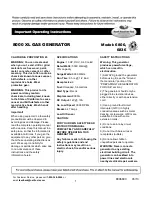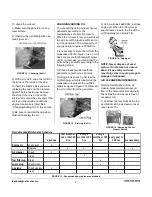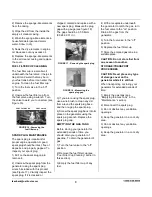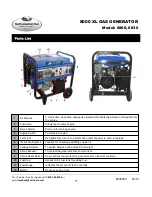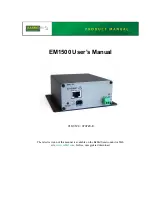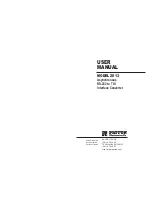
6
Once you have determined what
electrical devices you will be
powering with the generator, connect
these devices according to the
following procedure:
1) Plug in each electrical device with
the device turned off.
NOTE:
Be sure
to attach appliances to the correct
receptacle (outlet). Connect standard
120 Volt, single phase, 60 Hz loads
only
to the 120 Volt receptacles.
Connect 120/140 Volt, single phase,
60 Hz loads with a NEMA L14-30
plug
only
to the 120/140 Volt
receptacle. See Figure 9 for a
depiction of each of these
receptacles.
2) Check that the pilot light is lit
under the engine switch.
SOME NOTES ABOUT POWER
CORDS
Long or thin cords can drain the
power provided to an electrical
device by the generator. When using
such cords, allow for a slightly
higher rated wattage requirement by
the electrical device. See Figure 10
for recommended cords based on
the power requirement of the
electrical device.
STOPPING THE GENERATOR
To stop the generator:
1) Turn off, then unplug all
connected electrical devices.
2) Allow the generator to run for
several more minutes with no
electrical devices connected. This
helps stabilize the temperature of
the generator.
3) Turn engine switch key to the “off”
position. Remove the key.
4) Turn the fuel valve to the “off”
position.
WARNING: Allow the generator to
cool for several minutes before
touching areas that become hot
during use.
CAUTION: Allowing gas to sit in
the generator tank for long
periods of time without use can
make it difficult to start the
generator in the future. Never
store the generator for
extended
periods of time with fuel in the
tank.
MAINTENANCE/CARE
Proper routine maintenance of your
generator will help prolong the life of
your machine. Please perform
maintenance checks and operations
according to the schedule in Figure
11, on page 6.
CAUTION: Never perform
maintenance operations while the
generator is running.
CLEANING THE GENERATOR
Always try to use your generator in a
cool, dry place. In the event your
generator becomes dirty, you may
clean the exterior with one or more
of the following:
- a damp cloth
-
a soft brush
- a vacuum
- pressurized air
Never clean your generator with a
bucket of water or a hose. Water
can get inside the working parts of
the generator and cause a short
circuit or corrosion.
CHECKING THE OIL
The generator is equipped with an
automatic shutoff to protect it from
running on low oil. Nonetheless, you
should check the oil level of the
generator before each use to ensure
that the generator crankcase has a
sufficient amount.
feedback@natitools.com
Amps
Watts (120V)
Watts (240 V)
#8 wire
#10 wire
#12 wire
#14 wire
#16 wire
5
600
1200
NR
500
300
200
125
7.5
900
1800
NR
350
200
125
100
10
1200
2400
NR
250
150
100
50
15
1800
3600
NR
150
100
65
NR
20
2400
4800
175
125
75
50
NR
25
3000
6000
150
100
60
NR
NR
30
3600
7200
125
65
NR
NR
NR
Device Requirements
Max. Cord Length (ft) by Wire Gauge
*NR= not recommended
FIGURE 10 - Maximum extension cord lengths by power requirement
FIGURE 9 - Receptacles available
on the generator

